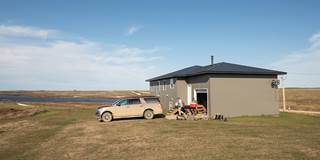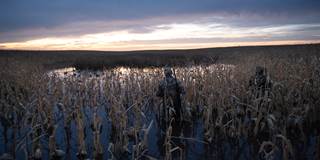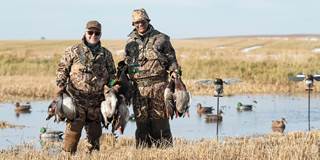Fall Break on the Prairies
On a freelance hunting adventure in North Dakota, a father and son find themselves at the intersection of waterfowling dreams and reality
On a freelance hunting adventure in North Dakota, a father and son find themselves at the intersection of waterfowling dreams and reality

Photography by BILL BUCKLEY
I picked up Jack at the Bismarck airport and drove north, through the glaciated Great Plains, through the prairie pothole country. Along the way I caught glimpses of his face as he watched through the window of the rental truck. Potholes and cattail sloughs, rolling fields of corn and beans and peas, pockets of prairie clad in thigh-high grasses. This was what he'd heard of, time and again. It was what he'd dreamed of, year after year. I watched his reflection in the side-window glass, a lucent ghost image of my son sailing across the North Dakota plains as we headed north, and then east, and then north for many more miles.
For as long as he had known such a place existed, Jack had wanted to hunt the prairie potholes. There is no more storied region in waterfowling lore, no place where dreams and possibility seem to dance in each other's arms so tantalizingly within reach. But there's no time to squeeze a prairie pothole DIY duck-hunting trip into a Southern boy's high school calendar. A long weekend isn't long enough to fly west, find birds, secure permission, and pull off a freelancing adventure.
But a college fall break is long enoughespecially when a father-approved "fall break stretcher" is applied to the calendar. So, with a college freshman in the passenger seat, I drove north, fueled by a lifelong dream and the delicious guilt of playing hooky.

Still, as the miles and the potholes and the flocks of ducks passed by, my anxiety rose. As badly as Jack wanted this, I wanted this to work even more deeply. I wanted Jack to experience the wonder that a prairie pothole hunt can be. Like any father, I wanted my child's dream to rub shoulders with reality.
But this I also knew: Dream or no dream, duck hunting anywhere is duck hunting nonetheless. And that can be a cold, hard fact.
The weather that greeted us on the prairies was a prime example. A massive blizzard crushed North Dakota with an early October storm just a few days before our arrival. Bismarck saw 18 inches of snow. Some areas of the state groaned under three feet. And true winter was still weeks away.
On our first morning's hunt, we loaded decoy packs and sleds for a 400-yard march to a snowy pothole where hunkered-down ducks had ridden out the storm. With nothing to go on but the previous afternoon's long-distance scouting, we soon found ourselves lost in huge sweeps of snowfield and frozen marsh. From the county road, getting to the water looked easy. It was a different matter in the dark, in the snow, with flashlights reflecting like airport searchlights. It took us more than an hour to find a pothole we thought we'd saunter up to in 20 minutes. Soaked with sweat, we scrambled to get the decoys out and get hidden before shooting light.
Thankfully, the ducks never forgot where the pothole was located.
Jack took his first one in the weak light before dawn, a mallard that crumpled in the sheet water not 15 feet in front of him. "I know we're trying to shoot just drakes," he laughed, calling over to where I rocked on a five-gallon bucket in the marsh nearby. "But I really wanted to get that first shot behind me!"
He took his last shot with me by his shoulderour first two limits in the prairie potholes.
Finally. He saw for himself what it can be.

And he experienced what it takes. Before we left for North Dakota, Jack was trying to imagine what the days would be like. If we're lucky, he said, we could be limited out by mid-morning. "So what are we going to do all day?" he asked.
"You'll be begging for a nap," I laughed. "But there probably won't even be time for that."
We pulled the decoys, slogged to the truck, and headed back to the farmhouse we'd rented for the trip. Sort through gear, spread out the waders to dry in the biting wind, a quick lunch, then an hour and a half of duck plucking, gutting, and freezer-bagging. "Holy cow, it's almost one o'clock!" We scrolled through our maps and notes and made a few calls about spots we'd found earlier. "If we're going to scout, we've got to get rolling. Grab your binoculars. Is your phone charged?" So much for that nap.
Hunt, sort, eat, pluck, scout, sleep, repeat. On a prairie pothole DIY trip, you're guide, chef, housekeeping staff, lodge manager, and hunter to boot. You beg for more hours in the day.
Pulling off a long-distance seat-of-your-pants hunt like this requires waders, decoys, binoculars, and the energy of a six-month-old puppy. You could fly it blind, of course, but it helps to have help. I called every hunting buddy I knew for any North Dakota connection. A couple of pals had hunted the state for years, so I borrowed a few dozen of their decoys and made sure I steered clear of their home turf. I leaned on another friend and former DU employee for anyone who knew anybody who might have a rental house. If you're a duck hunter anywhere in America, you might be surprised to find that only a few degrees of separation lie between you and a mallard-filled pothole. You just have to dig deep in your contacts list.

And once you're on the ground, good manners don't hurt. North Dakota is well known for its law providing open hunting access to private lands that aren't posteda heritage that is under reviewbut I've never felt 100 percent comfortable hunting without solid permission in hand. Even on blocks of land that weren't posted, we tried to hunt down landowners and introduce ourselves.
That's part of the fun, but, in fact, I came close to passing up one of our best hunting locations. It was the day before Jack arrived in Bismarck. As I was cruising a county road for ducks, a movement caught my eye. A single bird flew low over a cornfield, like a pelican cruising the beach. Suddenly it set its wings and vanished in the middle of 40 acres of standing corn.
I hit the brakes and grabbed the binoculars. Another duck followed the same flight line and vanished as quickly as the first. Then a pair. Then five. Then more. Within three minutes, 20 ducks had simply disappeared in the middle of what appeared to be a vast, unremarkable field of standing corn. But the fieldand the entire farm, nearly two miles longwas heavily posted. More ducks bombed in. I set my jaw and cranked on the engine.

A long gravel driveway took me over two ridgetops, around a pair of sloughs, and into the lot of a large farming operation. Tractors everywhere, a pair of big combines, a massive metal barn, a half-dozen pickups, and two happy retrievers watching my approach. My heart sank. It just had the feel of a big, fat "No." It would be awkward walking into a scene like that, twisting my hat, asking for a favor. I found the farmer in the work barn, pounding a stuck lug on a combine wheel. I made a homespun pitch. I paraded the image of a father-and-son hunt in front of the man. With permission in hand, it took all the restraint I could muster not to sling gravel up the road as I roared back to the cornfield.
We let the spot rest for three days and then made our move. Chad Haschen, a former engineering technician with Ducks Unlimited and an avid waterfowler, joined Jack and me as we slipped into the field an hour before shooting light. We shouldered decoy packs through 300 yards of standing corn and a half-foot of snow, and we set our decoys in a flooded slough between two slight rises in the field.
Our backs against the corn, Jack and I whispered in the dark.

"What do you think, Dad?" he asked. "Are they coming back?"
"Man, I can't imagine they wouldn't," I replied, imagining that very thing. "They were pouring in here during the middle of the day. But this is duck hunting, you know."
The first ducks came in the almost black dark, landing 10 feet away. We held our fire and held our breath, waiting for the cricket alarm on my cell phone to signal legal light.
More ducks in the decoys.
"Not yet. Not yet."
Three days earlier I'd seen scads of mallards and teal drop into this honey hole. On this morning the ducks returned, coming in low over the tassels, by the ones and twos and dozens at a time, hovering over the slough for half a second as they set their wings for descent. Had we not come from so far, and worked so hard, three 90-minute limits might have made us feel a little guilty.

Two days later I eased the truck up a rise on a dirt road and rolled to a stop. A great sweep of cornfield and cattle pasture unfurled in 360 degrees, all pocked with pothole water. But that's not why we were there. On the hilltop there's enough elevation for a strong cell phone signal. It was time to get to work.
Jack and I divvied up the labor. We had a list of landowner names we'd tallied from four days of scouting. I had the old-school local telephone book I borrowed from our rental farmhouse. Jack had a 20-year-old's grasp of social media and Internet research, and thumbs that fly over the smartphone screen faster than an old-time gunslinger's six-shooter draw.
"I think I found Mr. Steger's daughter," Jack said. "Or maybe she's a cousin. Hard to tell. But it looks like she lives a couple counties over."
"Pretty close," I replied. I didn't ask how he found her. I didn't really want to know. "Gimme the number."
And sure enough, Mr. Steger's daughter had Mr. Steger's phone number, so I gave it a try. The older gentleman's wife answered the call. Her husband wasn't in the house, she said, almost apologetically, but she thought she heard him puttering around in the utility shed out back. "Hold on just a minute," she said, "and let me go get him."
Jack and I shook our heads. If we tried this back home, the eastern North Carolina version of Mr. Steger would be barreling toward us in his pickup right about now, wanting to know how we got his daughter's phone number and who in the pure-T hell did we think we were?
There were plenty of more traditional interactions with landowners. We knocked on doors and left notes on farm porches. We heard "yes" and "no" and drawn-out excuses from kind landowners who just couldn't bring themselves to turn us away outright. "Oh, any other time would be just fine, but this week my wife's brother's dentist's grandkids are hunting that farm."
Overall, the graciousness of North Dakota's landowners felt like home. Jack and I talked about it time and time again. These folks are incredibly nice. They might give a Southerner a run for the hospitality award.
One old farmer in particular made an impression. Late one afternoon we'd watched scores of ducks sift into a flooded corner of a low-lying stubble field. It looked no different from a hundred other flooded low spots we'd seen, except for the ducks that were being sucked into that 300-square-foot slice of North Dakota. We found the landowner's name and address and pulled into a trim little complex nearbya farmhouse, a few outbuildings, dogs barking in a bay window. We knocked on the door twice, and just as I was about to turn away, an older gentleman swung the door open wide. He was still chewing his supper, and a few crumbs were nestled on his lip. Uh-oh, I thought. Getting a man up from his dinner is a rookie move.
But the old man brightened when we introduced ourselves. We asked how long he'd been in the area, and he told us about his immigrant father. He'd been married now for more than 60 years, he said with pride, and owned a large block of land that stretched from north to south.
"I know that water you're talking about," he nodded. "Sure, you can hunt it. Hunt anything with my name on it, and I appreciate you asking."
We could barely hold in the excitement. "That's the gold!" Jack hollered as we pulled out of the driveway.

And the next morning was gold indeed. The mallards played strictly by the mallard playbook, dribbling in slowly at sunrise, just enough birds to keep us hoping for more, and just few enough to make us wonder if the greenhead mother lode had skipped town.
It had not.
When the heavens opened, they poured mallards the size of small geese, with scattered showers of gadwalls and wigeon. We tried to pick out the drakes to make the fun last, and then traded shots, father and son, to make it last even longer.
And when it was all over, I watched Jack pull his decoy sled out of the pothole and head up the long hill of frozen stubble toward the truck. I knew then that he'd learned not one, but two lessons in those North Dakota potholes:
First, dreams don't always come true.
But on the other hand ...

Ducks Unlimited uses cookies to enhance your browsing experience, optimize site functionality, analyze traffic, and deliver personalized advertising through third parties. By continuing to use this site, you agree to our use of cookies. View Privacy Policy